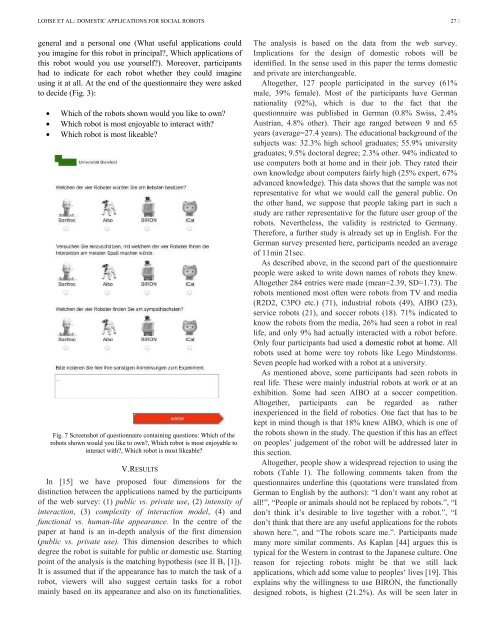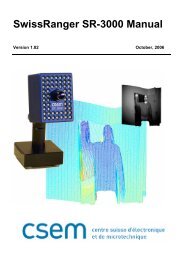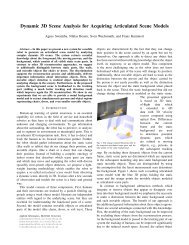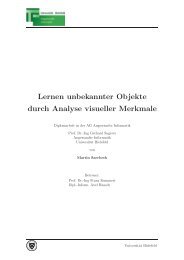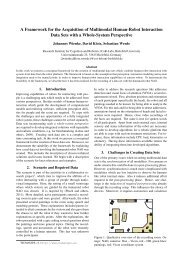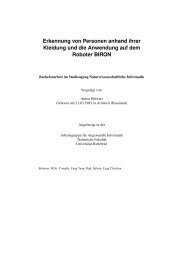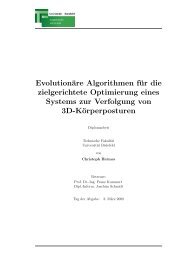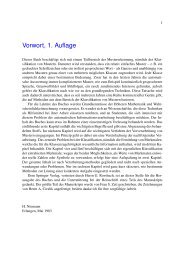Domestic Applications for Social Robots - Journal of Physical Agents
Domestic Applications for Social Robots - Journal of Physical Agents
Domestic Applications for Social Robots - Journal of Physical Agents
Create successful ePaper yourself
Turn your PDF publications into a flip-book with our unique Google optimized e-Paper software.
LOHSE ET AL.: DOMESTIC APPLICATIONS FOR SOCIAL ROBOTS 27<br />
general and a personal one (What useful applications could<br />
you imagine <strong>for</strong> this robot in principal?, Which applications <strong>of</strong><br />
this robot would you use yourself?). Moreover, participants<br />
had to indicate <strong>for</strong> each robot whether they could imagine<br />
using it at all. At the end <strong>of</strong> the questionnaire they were asked<br />
to decide (Fig. 3):<br />
• Which <strong>of</strong> the robots shown would you like to own?<br />
• Which robot is most enjoyable to interact with?<br />
• Which robot is most likeable?<br />
Fig. 7 Screenshot <strong>of</strong> questionnaire containing questions: Which <strong>of</strong> the<br />
robots shown would you like to own?, Which robot is most enjoyable to<br />
interact with?, Which robot is most likeable?<br />
V. RESULTS<br />
In [15] we have proposed four dimensions <strong>for</strong> the<br />
distinction between the applications named by the participants<br />
<strong>of</strong> the web survey: (1) public vs. private use, (2) intensity <strong>of</strong><br />
interaction, (3) complexity <strong>of</strong> interaction model, (4) and<br />
functional vs. human-like appearance. In the centre <strong>of</strong> the<br />
paper at hand is an in-depth analysis <strong>of</strong> the first dimension<br />
(public vs. private use). This dimension describes to which<br />
degree the robot is suitable <strong>for</strong> public or domestic use. Starting<br />
point <strong>of</strong> the analysis is the matching hypothesis (see II B, [1]).<br />
It is assumed that if the appearance has to match the task <strong>of</strong> a<br />
robot, viewers will also suggest certain tasks <strong>for</strong> a robot<br />
mainly based on its appearance and also on its functionalities.<br />
The analysis is based on the data from the web survey.<br />
Implications <strong>for</strong> the design <strong>of</strong> domestic robots will be<br />
identified. In the sense used in this paper the terms domestic<br />
and private are interchangeable.<br />
Altogether, 127 people participated in the survey (61%<br />
male, 39% female). Most <strong>of</strong> the participants have German<br />
nationality (92%), which is due to the fact that the<br />
questionnaire was published in German (0.8% Swiss, 2.4%<br />
Austrian, 4.8% other). Their age ranged between 9 and 65<br />
years (average=27.4 years). The educational background <strong>of</strong> the<br />
subjects was: 32.3% high school graduates; 55.9% university<br />
graduates; 9.5% doctoral degree; 2.3% other. 94% indicated to<br />
use computers both at home and in their job. They rated their<br />
own knowledge about computers fairly high (25% expert, 67%<br />
advanced knowledge). This data shows that the sample was not<br />
representative <strong>for</strong> what we would call the general public. On<br />
the other hand, we suppose that people taking part in such a<br />
study are rather representative <strong>for</strong> the future user group <strong>of</strong> the<br />
robots. Nevertheless, the validity is restricted to Germany.<br />
There<strong>for</strong>e, a further study is already set up in English. For the<br />
German survey presented here, participants needed an average<br />
<strong>of</strong> 11min 21sec.<br />
As described above, in the second part <strong>of</strong> the questionnaire<br />
people were asked to write down names <strong>of</strong> robots they knew.<br />
Altogether 284 entries were made (mean=2.39, SD=1.73). The<br />
robots mentioned most <strong>of</strong>ten were robots from TV and media<br />
(R2D2, C3PO etc.) (71), industrial robots (49), AIBO (23),<br />
service robots (21), and soccer robots (18). 71% indicated to<br />
know the robots from the media, 26% had seen a robot in real<br />
life, and only 9% had actually interacted with a robot be<strong>for</strong>e.<br />
Only four participants had used a domestic robot at home. All<br />
robots used at home were toy robots like Lego Mindstorms.<br />
Seven people had worked with a robot at a university.<br />
As mentioned above, some participants had seen robots in<br />
real life. These were mainly industrial robots at work or at an<br />
exhibition. Some had seen AIBO at a soccer competition.<br />
Altogether, participants can be regarded as rather<br />
inexperienced in the field <strong>of</strong> robotics. One fact that has to be<br />
kept in mind though is that 18% knew AIBO, which is one <strong>of</strong><br />
the robots shown in the study. The question if this has an effect<br />
on peoples’ judgement <strong>of</strong> the robot will be addressed later in<br />
this section.<br />
Altogether, people show a widespread rejection to using the<br />
robots (Table 1). The following comments taken from the<br />
questionnaires underline this (quotations were translated from<br />
German to English by the authors): “I don’t want any robot at<br />
all!”, “People or animals should not be replaced by robots.”, “I<br />
don’t think it’s desirable to live together with a robot.”, “I<br />
don’t think that there are any useful applications <strong>for</strong> the robots<br />
shown here.”, and “The robots scare me.”. Participants made<br />
many more similar comments. As Kaplan [44] argues this is<br />
typical <strong>for</strong> the Western in contrast to the Japanese culture. One<br />
reason <strong>for</strong> rejecting robots might be that we still lack<br />
applications, which add some value to peoples‘ lives [19]. This<br />
explains why the willingness to use BIRON, the functionally<br />
designed robots, is highest (21.2%). As will be seen later in


